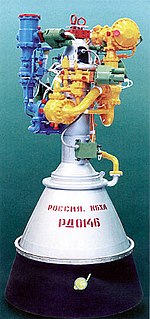RD-0146
 Model of RD-0146 | |
| Country of origin | Russia |
|---|---|
| Date | 2001 |
| Designer | KBKhA Design Bureau |
| Manufacturer | TsSKB Progress |
| Application | upper stage |
| Associated LV | KVTK |
| Liquid-fuel engine | |
| Propellant | LOX / LH2 |
| Cycle | Expander cycle |
| Configuration | |
| Chamber | 1 |
| Performance | |
| Thrust (vac.) | 68.6 kN (15,400 lbf) |
| Chamber pressure | 5.9 megapascals (860 psi) |
| Isp (vac.) | 470 seconds (4.6 km/s) |
| Dimensions | |
| Length | 3.558 metres (11.67 ft) |
| Diameter | 1.95 metres (6 ft 5 in) |
The RD-0146 is a Russian cryogenic rocket engine. The RD-0146 engine was developed by KBKhA design bureau in Voronezh, Russia, in cooperation with the American Pratt & Whitney Rocketdyne company. In 2009, it came into prominence, as Russian space agency chose it for the second-stage of the proposed Rus-M launch vehicle designed to carry the future Russian PPTS crewed spacecraft.[1][full citation needed] After the cancellation of Rus-M rocket, the RD-0146D variant was selected as the powerplant for the KVTK upper stage.
Development[]
In 1999, Khrunichev requested KBKhA to develop RD-0146U version of the engine for Proton and Angara rockets. The development of the engine was partially financed by Pratt & Whitney Rocketdyne. Pratt & Whitney signed a preliminary marketing agreement on April 7, 2000 with Russia's Chemical Automatics Design Bureau giving Pratt & Whitney exclusive international marketing rights to the RD-0146.[1]
Description[]
The RD-0146 is the first Russian rocket engine not to feature a gas generator and to be equipped with extendable nozzle extension without a cooling system. The engine is capable of five firings and thrust control in two planes. According to the developer, the lack of a gas generator system ensures higher reliability of the engine for multiple firings, by removing the potential of an ignition failure in the engine power cycle.[citation needed]
Related development[]
LM10-MIRA is a Liquid oxygen-Liquid methane demonstrator engine developed by Avio and KBKhA from RD-0146 under an agreement signed between Italian and Russian governments in Moscow on November 28, 2000. The 7.5t engine was successful tested in June 2014 in Voronezh, Russia.[2] After the end of the collaboration with KHBhA, Avio continued the development of the M10 engine under the Vega-Evolution program with a target thrust of 10t.[3] As of March 2021 the engine ground qualification is foreseen for 2024.[3]
See also[]
- Avio M10 a derived engine in development for Vega
- Comparison of orbital rocket engines
Comparable engines[]
References[]
- ^ Jump up to: a b "RD-0146 rocket engine".
- ^ P. Bellomi; M. Rudnykh; S. Carapellese; D. Liuzzi; G. Caggiano; L. Arione; A.A. Gurtovoy; S.D. Lobov; V. S. Rachuk (2019-02-08). "Development of LM10-MIRA liquid oxygen – liquid natural gas expander cycle demonstrator engine". Progress in Propulsion Physics – Volume 11. pp. 447–466. doi:10.1051/eucass/201911447. ISBN 978-5-94588-228-7. Retrieved 2021-03-23.
- ^ Jump up to: a b D. Kajon; D.Liuzzi; C. Boffa; M. Rudnykh; D. Drigo; L. Arione; N. Ierardo; A. Sirbi (2019-08-01). "Development of the liquid oxygen and methane M10 rocket engine for the Vega-E upper stage" (PDF). doi:10.13009/EUCASS2019-315. Retrieved 2021-03-24. Cite journal requires
|journal=(help)
External links[]
- KBKhA RD-0146
- RD-0146 Specifications
- RD-0146 description from Pratt & Whitney Rocketdyne [1]
- Rocket engines of Russia
- Rocket engines using hydrogen propellant
- Soviet inventions
- Rocket engines using the expander cycle
- KBKhA rocket engines

